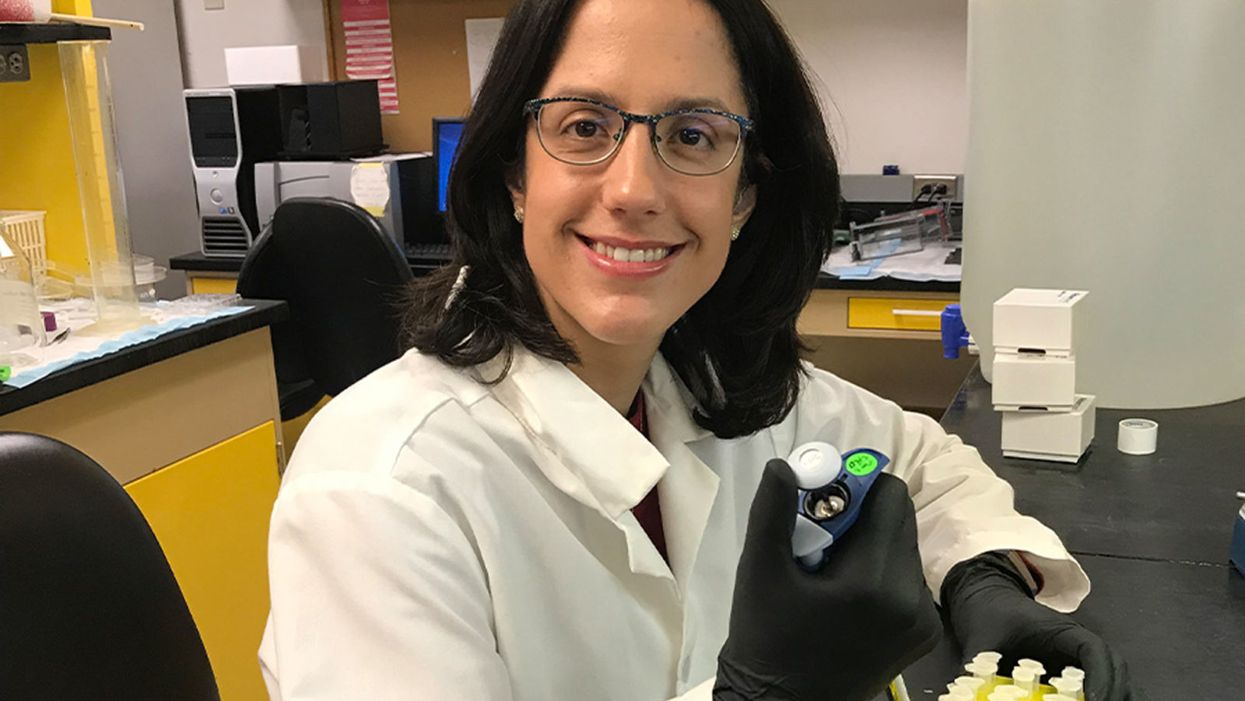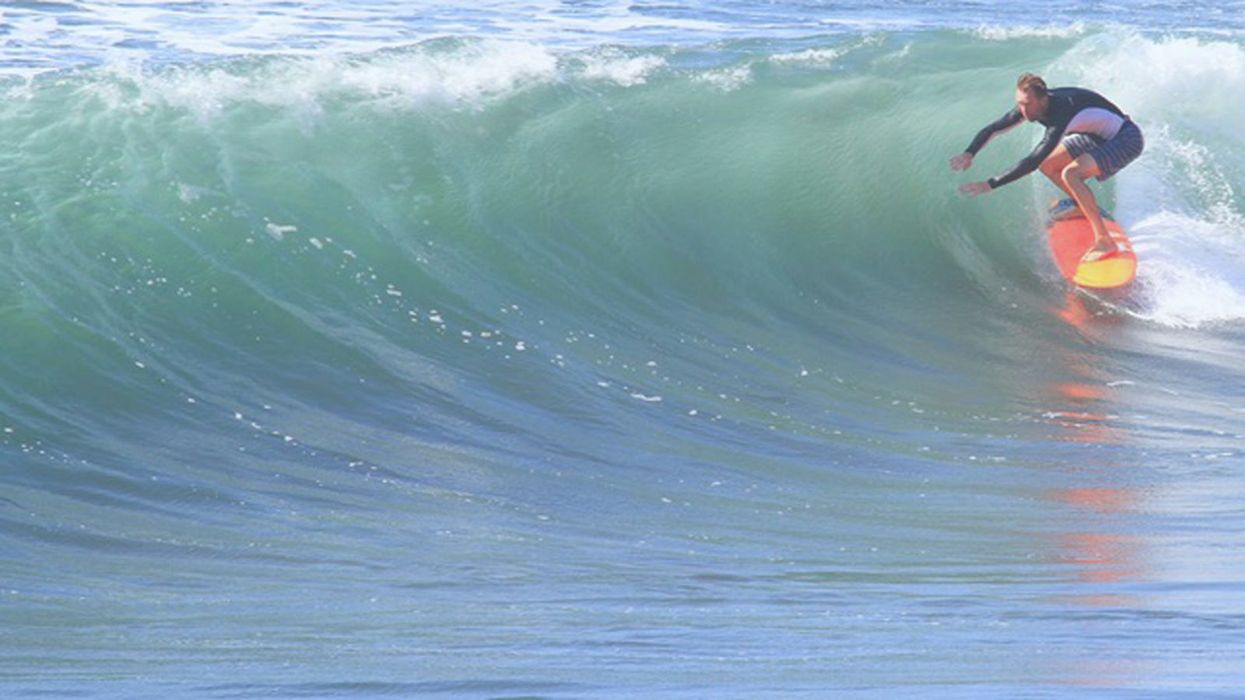Deaf Scientists Just Created Over 1000 New Signs to Dramatically Improve Ability to Communicate
Sarah Latchney, the first deaf PhD student at the University of Rochester School of Medicine & Dentistry, pictured here at work at a lab in the department of environmental sciences.
For the deaf, talent and hard work may not be enough to succeed in the sciences. According to the National Science Foundation, deaf Americans are vastly underrepresented in the STEM fields, a discrepancy that has profound economic implications.
The problem with STEM careers for the deaf and hard-of-hearing is that there are not enough ASL signs available.
Deaf and hard-of-hearing professionals in the sciences earn 31 percent more than those employed in other careers, according to a 2010 study by the National Technical Institute for the Deaf (NTID) in Rochester, N.Y., the largest technical college for deaf and hard-of-hearing students. But at the same time, in 2017, U.S. students with hearing disabilities earned only 1.1 percent of the 39,435 doctoral degrees awarded in science and engineering.
One reason so few deaf students gravitate to science careers and may struggle to complete doctoral programs is the communication chasm between deaf and hard-of-hearing scientists and their hearing colleagues.
Lorne Farovitch is a doctoral candidate in biomedical science at the University of Rochester of New York. Born deaf and raised by two deaf parents, he communicated solely in American Sign Language (ASL) until reaching graduate school. There, he became frustrated at the large chunk of his workdays spent communicating with hearing lab mates and professors, time he would have preferred spending on his scientific work.
The problem with STEM careers for the deaf and hard-of-hearing is that there are not enough ASL signs available, says Farovitch. Names, words, or phrases that don't exist in ASL must be finger spelled — the signer must form a distinct hand shape to correspond with each letter of the English alphabet, a tedious and time-consuming process. For instance, it requires 12 hand motions to spell out the word M-I-T-O-C-H-O-N-D-R-I-A. Imagine repeating those motions countless times a day.
To bust through this linguistic quagmire, Farovitch, along with a team of deaf STEM professionals, linguists, and interpreters, have been cooking up signs for terms like Anaplasma phagocytophilum, the tick-borne bacterium Farovitch studies. The sign creators are then videotaped performing the new signs. Those videos are posted on two crowd-sourcing sites, ASLcore.org and ASL Clear.
The beauty of ASL is you can express an entire concept in a single sign, rather than by the name of a word.
"If others don't pick it up and use it, a sign goes extinct," says Farovitch. Thus far, more than 1,000 STEM terms have been developed on ASL Clear and 500 vetted and approved by the deaf STEM community, according to Jeanne Reis, project director of the ASL Clear Project, based at The Learning Center for the Deaf in Framingham, Mass.
The beauty of ASL is you can express an entire concept in a single sign, rather than by the name of a word. The signs are generally intuitive and wonderfully creative. To express "DNA" Farovitch uses two fingers of each hand touching the tips of the opposite hand; then he draws both the hands away to suggest the double helix form of the hereditary material present in most organisms.
"If you can show it, you can understand the concept better,'' says the Canadian-born scientist. "I feel I can explain science better now."
The hope is that as ASL science vocabulary expands more, deaf and hard-of-hearing students will be encouraged to pursue the STEM fields. "ASL is not just a tool; it's a language. It's a vital part of our lives," Farovitch explains through his interpreter.
The deaf community is diverse—within and beyond the sciences. Sarah Latchney, PhD, an environmental toxicologist, is among the approximately 90 percent of deaf people born to hearing parents. Hers made sure she learned ASL at an early age but they also sent Latchney to a speech therapist to learn to speak and read lips. Latchney is so adept at both that she can communicate one-on-one with a hearing person without an interpreter.
Like Favoritch, Latchney has developed "conceptually accurate" ASL signs but she has no plans to post them on the crowd-sourcing sites. "I don't want to fix [my signs]; it works for me," she explains.
Young scientists like Farovitch and Latchney stress the need for interpreters who are knowledgeable about science. "When I give a presentation I'm a nervous wreck that I'll have an interpreter who may not have a science background," Latchney explains. "Many times what I've [signed] has been misinterpreted; either my interpreter didn't understand the question or didn't frame it correctly."
To enlarge the pool of science-savvy interpreters, the University of Rochester will offer a new masters degree program: ASL Interpreting in Medicine and Science (AIMS), which will train interpreters who have a strong background in the biological sciences.
Since the Americans with Disabilities Act was enacted in 1990, opportunities in higher education for deaf and hard-of-hearing students have opened up in the form of federally funded financial aid and the creation of student disability services on many college campuses. Still, only 18 percent of deaf adults have graduated from college, compared to 33 percent of the general population, according to a survey by the U.S. Census Bureau in 2015.
The University of Rochester and the Rochester Institute of Technology, home to NTID, have jointly created two programs to increase the representation of deaf and hard-of-hearing professionals in the sciences. The Rochester Bridges to the Doctorate Program, which Farovitch is enrolled in, prepares deaf scholars for biomedical PhD programs. The Rochester Postdoctoral Partnership readies deaf postdoctoral scientists to successfully attain academic research and teaching careers. Both programs are funded by the National Institutes of Science. In the last five years, the University of Rochester has gone from zero deaf postdoctoral and graduate students to nine.
"Deafness is not a problem, it's just a difference."
It makes sense for these two private universities to support strong programs for the deaf: Rochester has the highest per capita population of deaf or hard-of-hearing adults younger than 65 in the nation, according to the U.S. Census. According to the U.S. Department of Education, there are about 136,000 post-secondary level students who are deaf or hard of hearing.
"Deafness is not a problem, it's just a difference," says Farovitch. "We just need a different way to communicate. It doesn't mean we require more work."
Surfing for Science: A Fin Sensor Is Making Waves
Surfer David Walden in La Libertad, El Salvador in February 2018.
For David Walden, a Southern Californian, surfing is a lifestyle, not a hobby. The 38-year-old works nights at a seafood restaurant to leave his mornings free for surfing.
While the surfers are doing what they love, they are also collecting information that is helping scientists better understand the ocean.
"Once you fall in love with the ocean, you need it like a daily cleanse or refresher," he says. "The positive mental and physical effects of the ocean, the endorphins and dopamine, keep you addicted in a good way."
Given his dedication to surfing, Walden was delighted when he became one of more than 200 surfers last year to test Smartfin, a 5-1/2-inch surfboard fin that contains a circuit board, a rechargeable battery, a GPS device, a sensor that captures temperature to one-hundredth of a degree, and a motion sensor that tracks the movement of the waves. While Walden and his fellow surfers are doing what they love, they are also collecting information that is helping scientists better understand the health of the near-shore ocean and how its chemistry is shifting due to climate change.
"I'm excited to be a part of it," Walden says. "I like to tell people I surf for science."
Back on shore, the surfers download the Smartfin data via a smartphone app so they can be accessed by scientists and other interested parties. (You can see where Smartfin surfers go at this interactive map.)

By putting sensors directly onto surfboards, oceanographers can collect data to help them better understand the global-warming related changes occurring in coastal oceans in temperature, salinity, and pH, all properties that have huge implications for the species that live in near-shore ecosystems.
There is much unknown about coastal waters because it's so difficult to obtain meaningful measurements. Traditional methods to monitor the close shore, such as bottle samples and buoys, are time consuming and expensive and tend to get damaged by the surf.
The Smartfin is the brainchild of Dr. Andy Stern, a retired neurologist. He and his brother-in-law, sculptor and filmmaker Todd McGrain, run The Lost Bird Project, a nonprofit devoted to raising awareness about climate change and other environmental issues. Stern brought his super fin idea to engineer Benjamin Thompson, who spent several years creating a prototype in his garage workshop. Smartfin was further developed by scientists at the Scripps Institution of Oceanography at the University of California at San Diego.
"The big challenge was to make a sensor small enough to fit in the fin but still produce good measurements," says Andreas Andersson, an associate professor of geoscience research at Scripps.
The Surfrider Foundation, a surfer-led nonprofit environmental organization, came aboard two years ago to distribute the Smartfin to its San Diego members.
Smartfin has also made a splash with scientists at the University of the Sunshine Coast in Queensland on the eastern coast of Australia. They are using the fin's temperature sensor to better understand how climate change is affecting the movement and distribution of marine life. And at the Plymouth Marine Laboratory in Plymouth, United Kingdom, the Smartfin's precise temperature readings of the near-shore ocean's surface are being used to improve the accuracy of satellites that monitor the ocean from hundreds of miles away.
"It's hard to talk about climate change in a way that's not boring or gloomy, but there's nothing gloomy or depressing about surfers and Smartfin."
"The hope is that Smartfin will improve the satellite measurements, which could improve the retrieval of temperature data around the world," says Dr. Phil Bresnahan, Smartfin's lead engineer at Scripps. In the future, the fin will include sensors to measure pH, chlorophyll (algae), dissolved oxygen, and turbidity (water clarity).
Stern envisions a time when thousands of surfers, paddle boarders, and other water enthusiasts worldwide will have Smartfins and be downloading data for scientists and environmentalists. Right now, there are approximately 70 surfers in the San Diego area using Smartfin and an additional 30 globally.
Scientists have plenty of evidence that global warming is largely caused by humans. Now they are trying to figure out what the long-term effects of climate change may be. For example, scientists are trying to predict which sections of coral reef, which house 25 percent of marine species, are most vulnerable so interventions can be developed to save them. Because of its small size, Smartfin is ideal to measure temperature changes in coral reefs.
Smartfin was also intended to be an educational tool. "It's a great way to start a different conversation about climate change," says Stern. "It's hard to talk about climate change in a way that's not boring or gloomy, but there's nothing gloomy or depressing about surfers and Smartfin. People want to hear more."
Turning surfers into citizen scientists makes perfect sense, says David Pasquini, 35, a longtime surfer who works for the British Consulate General's office in Oceanside, Calif. "Anyone who spends a lot of time in the ocean is aware of the changes happening in the ecosystem, the climate," says Pasquini. "Everyone asks, 'What can I do?'" Surfing with Smartfin, Pasquini feels like he is giving back.
"I know the data will be analyzed and eventually used to make a policy that helps with climate change. That's a great feeling--just by surfing, doing something you love, you're contributing."

